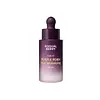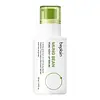What's inside
What's inside
 Key Ingredients
Key Ingredients

 Benefits
Benefits

 Concerns
Concerns

 Ingredients Side-by-side
Ingredients Side-by-side

Water
Skin ConditioningButylene Glycol
HumectantGlycereth-26
HumectantNiacinamide
SmoothingGlycerin
HumectantOryza Sativa Bran Water
MaskingMethylpropanediol
SolventPropylene Glycol Dibenzoate
Skin ConditioningPolyglycerin-3
Humectant1,2-Hexanediol
Skin ConditioningC14-22 Alcohols
Emulsion StabilisingTromethamine
BufferingOryza Sativa Extract
AbsorbentSodium Dna
Skin ConditioningPanthenol
Skin ConditioningVitis Vinifera Fruit Extract
Skin ConditioningDiospyros Kaki Leaf Extract
Skin ProtectingPolygonum Cuspidatum Root Extract
AntioxidantCoffea Arabica Seed Extract
MaskingCarthamus Tinctorius Flower Extract
Skin ConditioningZanthoxylum Piperitum Fruit Extract
Skin ConditioningCastanea Crenata Shell Extract
Skin ConditioningCamellia Sinensis Leaf Extract
AntimicrobialCaprylic/Capric Triglyceride
MaskingSodium Hyaluronate
HumectantHydrolyzed Collagen
EmollientGluconolactone
Skin ConditioningCapryloyl Salicylic Acid
ExfoliatingHydrogenated Lecithin
EmulsifyingHydrolyzed Elastin
EmollientCeramide NP
Skin ConditioningHouttuynia Cordata Extract
Skin ConditioningMelaleuca Alternifolia Leaf Extract
PerfumingCeramide AP
Skin ConditioningCeramide EOP
Skin ConditioningCopper Tripeptide-1
Skin ConditioningAllantoin
Skin ConditioningHydroxyacetophenone
AntioxidantCarbomer
Emulsion StabilisingSodium Polyacrylate
AbsorbentEthylhexylglycerin
Skin ConditioningCaprylyl Glycol
EmollientPropanediol
SolventAcrylates/C10-30 Alkyl Acrylate Crosspolymer
Emulsion StabilisingC12-20 Alkyl Glucoside
EmulsifyingHydrogenated Polydecene
EmollientMelia Azadirachta Leaf Extract
Skin ConditioningMelia Azadirachta Flower Extract
Skin ConditioningAdenosine
Skin ConditioningXanthan Gum
EmulsifyingDisodium EDTA
Coccinia Indica Fruit Extract
Skin ConditioningCentella Asiatica Extract
CleansingMalt Extract
Skin ProtectingGlyceryl Acrylate/Acrylic Acid Copolymer
HumectantTrideceth-6
EmulsifyingSolanum Melongena Fruit Extract
Skin ConditioningCyanocobalamin
Skin ConditioningSodium Phytate
C11-13 Isoparaffin
SolventOcimum Sanctum Leaf Extract
Skin ConditioningCorallina Officinalis Extract
Skin ConditioningCurcuma Longa Root Extract
MaskingWater, Butylene Glycol, Glycereth-26, Niacinamide, Glycerin, Oryza Sativa Bran Water, Methylpropanediol, Propylene Glycol Dibenzoate, Polyglycerin-3, 1,2-Hexanediol, C14-22 Alcohols, Tromethamine, Oryza Sativa Extract, Sodium Dna, Panthenol, Vitis Vinifera Fruit Extract, Diospyros Kaki Leaf Extract, Polygonum Cuspidatum Root Extract, Coffea Arabica Seed Extract, Carthamus Tinctorius Flower Extract, Zanthoxylum Piperitum Fruit Extract, Castanea Crenata Shell Extract, Camellia Sinensis Leaf Extract, Caprylic/Capric Triglyceride, Sodium Hyaluronate, Hydrolyzed Collagen, Gluconolactone, Capryloyl Salicylic Acid, Hydrogenated Lecithin, Hydrolyzed Elastin, Ceramide NP, Houttuynia Cordata Extract, Melaleuca Alternifolia Leaf Extract, Ceramide AP, Ceramide EOP, Copper Tripeptide-1, Allantoin, Hydroxyacetophenone, Carbomer, Sodium Polyacrylate, Ethylhexylglycerin, Caprylyl Glycol, Propanediol, Acrylates/C10-30 Alkyl Acrylate Crosspolymer, C12-20 Alkyl Glucoside, Hydrogenated Polydecene, Melia Azadirachta Leaf Extract, Melia Azadirachta Flower Extract, Adenosine, Xanthan Gum, Disodium EDTA, Coccinia Indica Fruit Extract, Centella Asiatica Extract, Malt Extract, Glyceryl Acrylate/Acrylic Acid Copolymer, Trideceth-6, Solanum Melongena Fruit Extract, Cyanocobalamin, Sodium Phytate, C11-13 Isoparaffin, Ocimum Sanctum Leaf Extract, Corallina Officinalis Extract, Curcuma Longa Root Extract
Water
Skin ConditioningGlycerin
HumectantDipropylene Glycol
HumectantNiacinamide
SmoothingXylitol
Humectant1,2-Hexanediol
Skin ConditioningButylene Glycol
HumectantHydroxyacetophenone
AntioxidantAcrylates/C10-30 Alkyl Acrylate Crosspolymer
Emulsion StabilisingVigna Radiata Seed Extract
Skin ConditioningTromethamine
BufferingEthylhexylglycerin
Skin ConditioningHydrolyzed Gardenia Florida Extract
AntioxidantHydrolyzed Malt Extract
Skin ConditioningHydrolyzed Viola Tricolor Extract
Skin ProtectingMenthoxypropanediol
MaskingAdenosine
Skin ConditioningTrisodium Ethylenediamine Disuccinate
Pentylene Glycol
Skin ConditioningGlyceryl Glucoside
HumectantPunica Granatum Flower Extract
Skin ConditioningDextrin
AbsorbentHyaluronic Acid
HumectantGardenia Florida Fruit Extract
Skin ConditioningPhaseolus Radiatus Seed Extract
Skin ConditioningAnanas Sativus Fruit Extract
Skin ConditioningMalus Domestica Fruit Extract
AntioxidantPrunus Persica Fruit Extract
AbrasiveVaccinium Angustifolium Fruit Extract
Skin ProtectingGlycogen
HumectantAcetyl Hexapeptide-8
HumectantWater, Glycerin, Dipropylene Glycol, Niacinamide, Xylitol, 1,2-Hexanediol, Butylene Glycol, Hydroxyacetophenone, Acrylates/C10-30 Alkyl Acrylate Crosspolymer, Vigna Radiata Seed Extract, Tromethamine, Ethylhexylglycerin, Hydrolyzed Gardenia Florida Extract, Hydrolyzed Malt Extract, Hydrolyzed Viola Tricolor Extract, Menthoxypropanediol, Adenosine, Trisodium Ethylenediamine Disuccinate, Pentylene Glycol, Glyceryl Glucoside, Punica Granatum Flower Extract, Dextrin, Hyaluronic Acid, Gardenia Florida Fruit Extract, Phaseolus Radiatus Seed Extract, Ananas Sativus Fruit Extract, Malus Domestica Fruit Extract, Prunus Persica Fruit Extract, Vaccinium Angustifolium Fruit Extract, Glycogen, Acetyl Hexapeptide-8
 Reviews
Reviews

Ingredients Explained
These ingredients are found in both products.
Ingredients higher up in an ingredient list are typically present in a larger amount.
1,2-Hexanediol is a synthetic liquid and another multi-functional powerhouse.
It is a:
- Humectant, drawing moisture into the skin
- Emollient, helping to soften skin
- Solvent, dispersing and stabilizing formulas
- Preservative booster, enhancing the antimicrobial activity of other preservatives
Acrylates/C10-30 Alkyl Acrylate Crosspolymer is a synthetic polymer. It is used to thicken and improve the texture of products. Due to its properties, it can prevent water and oil ingredients from separating.
Adenosine is in every living organism. It is one of four components in nucleic acids that helps store our DNA.
Adenosine has many benefits when used. These benefits include hydrating the skin, smoothing skin, and reducing wrinkles. Once applied, adenosine increases collagen production. It also helps with improving firmness and tissue repair.
Studies have found adenosine may also help with wound healing.
In skincare products, Adenosine is usually derived from yeast.
Learn more about AdenosineButylene Glycol (or BG) is used within cosmetic products for a few different reasons:
Overall, Butylene Glycol is a safe and well-rounded ingredient that works well with other ingredients.
Though this ingredient works well with most skin types, some people with sensitive skin may experience a reaction such as allergic rashes, closed comedones, or itchiness.
Learn more about Butylene GlycolEthylhexylglycerin (we can't pronounce this either) is commonly used as a preservative and skin softener. It is derived from glyceryl.
You might see Ethylhexylglycerin often paired with other preservatives such as phenoxyethanol. Ethylhexylglycerin has been found to increase the effectiveness of these other preservatives.
Glycerin is already naturally found in your skin. It helps moisturize and protect your skin.
A study from 2016 found glycerin to be more effective as a humectant than AHAs and hyaluronic acid.
As a humectant, it helps the skin stay hydrated by pulling moisture to your skin. The low molecular weight of glycerin allows it to pull moisture into the deeper layers of your skin.
Hydrated skin improves your skin barrier; Your skin barrier helps protect against irritants and bacteria.
Glycerin has also been found to have antimicrobial and antiviral properties. Due to these properties, glycerin is often used in wound and burn treatments.
In cosmetics, glycerin is usually derived from plants such as soybean or palm. However, it can also be sourced from animals, such as tallow or animal fat.
This ingredient is organic, colorless, odorless, and non-toxic.
Glycerin is the name for this ingredient in American English. British English uses Glycerol/Glycerine.
Learn more about GlycerinHydroxyacetophenone is antioxidant with skin conditioning and soothing properties. It also boosts the efficiency of preservatives.
This ingredient is not irritating or sensitizing.
Niacinamide is a multitasking form of vitamin B3 that strengthens the skin barrier, reduces pores and dark spots, regulates oil, and improves signs of aging.
And the best part? It's gentle and well-tolerated by most skin types, including sensitive and reactive skin.
You might have heard of "niacin flush", or the reddening of skin that causes itchiness. Niacinamide has not been found to cause this.
In very rare cases, some individuals may not be able to tolerate niacinamide at all or experience an allergic reaction to it.
If you are experiencing flaking, irritation, and dryness with this ingredient, be sure to double check all your products as this ingredient can be found in all categories of skincare.
When incorporating niacinamide into your routine, look out for concentration amounts. Typically, 5% niacinamide provides benefits such as fading dark spots. However, if you have sensitive skin, it is better to begin with a smaller concentration.
When you apply niacinamide to your skin, your body converts it into nicotinamide adenine dinucleotide (NAD). NAD is an essential coenzyme that is already found in your cells as "fuel" and powers countless biological processes.
In your skin, NAD helps repair cell damage, produce new healthy cells, support collagen production, strengthen the skin barrier, and fight environmental stressors (like UV and pollution).
Our natural NAD levels start to decline with age, leading to slower skin repair, visible aging, and a weaker skin barrier. By providing your skin niacinamide, you're recharging your skin's NAD levels. This leads to stronger, healthier, and younger looking skin.
Another name for vitamin B3 is nicotinamide. This vitamin is water-soluble and our bodies don't store it. We obtain Vitamin B3 from either food or skincare. Meat, fish, wheat, yeast, and leafy greens contain vitamin B3.
The type of niacinamide used in skincare is synthetically created.
Learn more about NiacinamideTromethamine helps balance the pH and improve the texture of a product. It is synthetically created.
As an emulsifier, Tromethamine prevents oil and water ingredients from separating. This helps stabilize the product and elongate a product's shelf life. Tromethamine also makes a product thicker.
Tromethamine helps balance the pH level of a product. Normal pH level of skin is slightly acidic (~4.75-5.5). The acidity of our skin is maintained by our glands and skin biome. Being slightly acidic allows our skin to create an "acid mantle". This acid mantle is a thin barrier that protects our skin from bacteria and contaminants.
Oral Tromethanmine is an anti-inflammatory drug but plays the role of masking, adding fragrance, and/or balancing pH in skincare.
1,3-Propanediol, 2-amino-2-(hydroxymethyl)-
Learn more about TromethamineWater. It's the most common cosmetic ingredient of all. You'll usually see it at the top of ingredient lists, meaning that it makes up the largest part of the product.
So why is it so popular? Water most often acts as a solvent - this means that it helps dissolve other ingredients into the formulation.
You'll also recognize water as that liquid we all need to stay alive. If you see this, drink a glass of water. Stay hydrated!
Learn more about Water